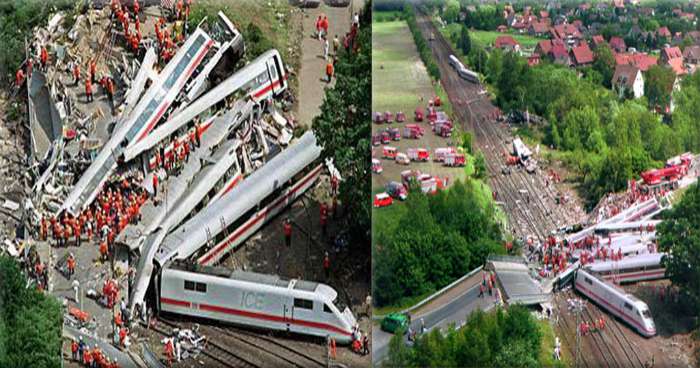Metal fatigue causes failure of structural elements. This fatigue can be a result of over-stress, and the 1842 Versailles train crash was attributed to metal fatigue in one of the axles of the engine.

Metal fatigue is quite often caused by repeated stress cycles. Rail axles are vital structural elements that endure the repeated stresses of rotation and transmission of vertical loads that they have to carry. They are therefore prime candidates for failure due to fatigue, and it is this metal fatigue that caused the May 1842 Versailles train crash. A locomotive engineer, Joseph Locke, was a witness to the accident, and his report on the accident led to a number of engineers joining in the discussion of the reasons for the calamity. This led to William Rankine investigating broken axles, and he was among the first to suggest the mechanism of the growth of cracks that lead to stress concentration and consequent failures.
Factors That Cause Fatigue
Repeated loading and unloading on metal elements, above a certain threshold, causes metal surfaces to exhibit microscopic cracks. The continued application of loads and the resultant stress causes the cracks to reach a critical size, which then causes the metal element to fracture.
Besides the cyclic state of stress, the geometry of a cross section can also lead to the buildup of stress in certain areas, which then induces the fracture. Other stresses can come from surface quality where roughness plays a part by allowing stress concentrations. The fatigue life of a metal is also dependent on its material composition or from residual stresses that are built into the metal component from the casting, cutting, welding, machining, forging, and other manufacturing processes that the component is subjected to. Casting can induce certain internal defects like porosity that have a bearing on the strength of the material and its behavior during repeated stress cycles. The grain size of the metal can also affect fatigue life, with smaller grain sizes encouraging longer lives.
The external factors that contribute to metal fatigue can include high temperatures and environmental conditions that cause deterioration or corrosion. The direction of the loading can also be a factor in the development of fatigue, although this is generally taken care of by the geometry factor, which designers take into consideration.
The Mechanisms of Metal Fatigue
It was only in the early 1900s that investigations were started into the mechanisms that cause metal fatigue. Ewing and Humphrey in 1903 concluded that metal fatigue is exhibited by damage shown on the surface of the metal. A slip line is the plane formed in any material that indicates the area that is under maximum stress, which can exceed the strength of the material. In a ductile material like rail axles, rails, or other structural components, such bands of slip lines form on the surface when the component is subjected to fatigue loading. These slip lines eventually become cracks. The depth of the crack continues to increase while being subjected to continued stress, and this ultimately leads to complete failure of the component.
Railways and Fatigue Failures

There is only a single point of contact between the rails and the wheels of railway carriages and engines. This leads to very large loads being carried by very small areas and causes excessive stresses that are normally much higher than the yield stress of the material. These stresses are repeated while the wheels continue to go over the rails, and this leads to the ductility of the material that forms the contact area to be exhausted. Once this happens, cracks start forming and lead to fatigue.
Railway engineers have tried to solve this problem by defining a life-span limit for most rail system components, whether they be rails, axles, or other parts. So even though the railways are considered a permanent system, their components have to be replaced with new ones once the life cycle has been completed.
The significant areas where fatigue failures occur are those normally adjacent to the wheel and rail interface, so this is where wheels, rails, and rail joints are most at risk. Improving technology has led to the reduction of rail joints by forming long rails without joints. Other areas in the system are affected by the forces that are generated because of the interface between the rails and the wheels. The main culprits here are the axles and wheels, which bear most of the load, but other things like bearings, gearboxes, and suspension components can also be affected and cause fatigue failure. External elements in a railway system that can result in fatigue failure are bridges, which again are subjected to repeated stress and cycles of loading and unloading.
Metallurgy has played a very important role in the development of railways, especially in the type of rails now being used. Other technological developments that have led to safer rail travel are magnetic levitation systems which reduce or eliminate contact between wheels and rails. It is this contact that causes the maximum stress on railway structures.


